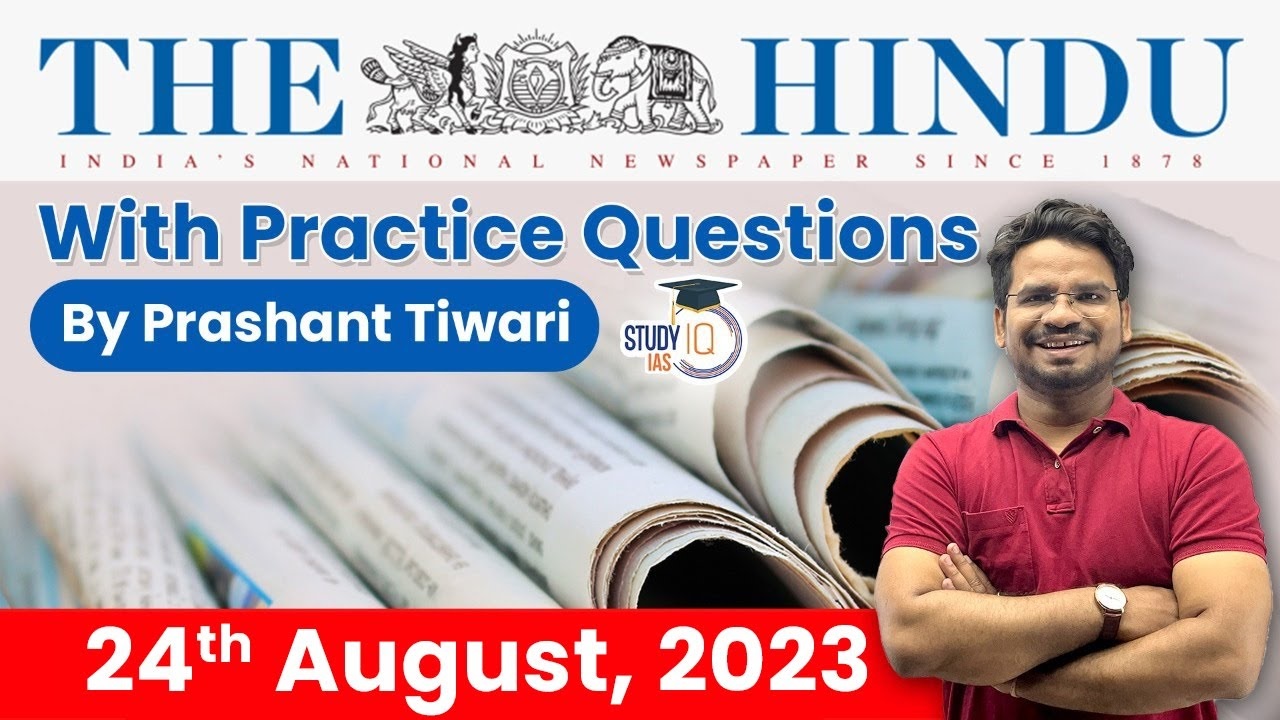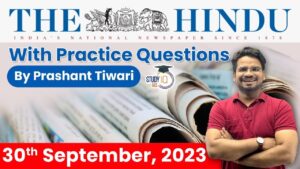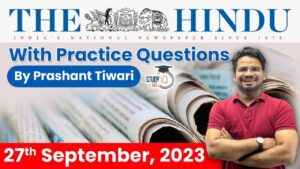The Hindu Newspaper Analysis for UPSC
- Chandrayaan-3’s lander touches down precisely at 6.03 p.m., sparking celebrations
- The success belongs to all of humanity. We can aspire for the moon and beyond: PM
- Communication link established between lander and mission centre in Bengaluru
- Rover will do chemical analysis of the lunar surface in the next 14 day.
- Precisely at 6.03 p.m., the lander touched the lunar surface and there were euphoric celebrations at the Mission Operations Complex (MOX) at ISRO Telemetry, Tracking, and Command Network (ISTRAC), Bengaluru, as India joined an elite list of countries — the U.S., Russia and China — to achieve this feat. India has also become the first nation to touch down on the polar region of the moon
- Constitutional mandate of scientific temper
- In 1976, the Government of India reemphasised its commitment to cultivate scientific temper through a constitutional amendment (Article 51A).
- Article 51A in the 42nd Amendment of the Constitution in 1976 says “It shall be the duty of every citizen of Indian to develop the scientific temper, humanism and the spirit of enquiry and reform.”

- Around 53% of all of the salaried workforce does not have any social security benefits in India, according to the Periodic Labour Force Survey Annual Report 2021-22, and which has been cited in the media. In effect, this means that such employees have no access to a provident fund, pension, and health care and disability insurance.
- Another conclusion is that just 1.9% of the poorest 20% quintile of India’s workforce has access to any benefits. Meanwhile, gig workers, or approximately 1.3% of India’s active labour force, rarely have access to any social security benefit.
- India’s social security system is also ranked poorly; Mercer CFS ranked it at 40 out of 43 countries in 2021.
- Approximately 91% (or around 475 million) of India’s workforce works in the informal sector. It lacks access to social security. In two decades, India will be an aging society — for such workers with limited savings, there will be no significant social protection. While the Code on Social Security (2020) merged existing social security legislation, it dealt fundamentally with formal enterprises and did not cover informal ones.
- There has been some progress. It was heartening to see the government push for a Code on Social Security in 2020, which sought to provide a statutory framework to enable social security for the urban and rural poor, construction workers, those in the gig industry and informal sector workers — it proposed the provision of life insurance, disability insurance, accident insurance, as well as maternity and health-care benefits along with old-age protection and crèche facilities for gig workers.
- We may also strengthen existing schemes, for example the Employees’ Provident Fund (EPF), the Employees’ State Insurance Scheme (ESI), and the National Social Assistance Programme (NSAP), with budgetary support and expansion of coverage.

- However, the adoption of AI in decision-making is not without its potential pitfalls. The biases inherent in AI, often a reflection of the biases in the data they are trained on or the perspectives of their developers, can lead to skewed or unjust outcomes and represent a significant challenge in the integration of AI into governance.
- Immanuel Kant’s ethical philosophy emphasises autonomy, rationality, and the moral duty of individuals. Applying Kantian ethics to the use of AI in decision-making within governance could lead to serious concerns.
- what if the decision taken on the basis of machine predictions or by a machine itself is immoral or unethical? Who will be held responsible? Will the liability fall on the AI system, the developer of the AI, or the official who relied on the AI’s data?

- One of the main topics at BRICS is Russia’s quest to create an alternative to the G-7-driven global political-economic model; however, unlike their counterparts in Russia and China, Indian officials have not spoken aggressively for de-dollarization
- India welcomes the expansion of the BRICS grouping through a consensus-based approach, Prime Minister Narendra Modi declared in Johannesburg on Wednesday.
- The current BRICS members are Brazil, Russia, India, China, and South Africa, whose names make up the group’s acronym.

- The Ministry of Road Transport and Highways has rolled out an indigenous star-rating system for crash testing cars under which vehicles will be assigned between one to five stars indicating their safety in a collision.
- Called the Bharat New Car Assessment Programme (NCAP), the rating system will be voluntary and will come into effect from October 1, 2023.
- The programme is applicable to passenger vehicles with not more than eight seats in addition to the driver’s seat with gross vehicle weight not exceeding 3,500 kgs. Only the base model of a particular variant will be tested.
- The objective of the programme is to help consumers make an informed decision before purchasing a car, thereby spurring demand for safer cars. India sees nearly 1.5 lakh road fatalities in a year, accounting for 10% of deaths due to road crashes globally with only 1% of the world’s vehicles. According to a World Bank study, road crashes are estimated to cost the Indian economy between 5 to 7% of GDP a year.
- The testing protocols adopted by the Bharat NCAP are modelled on the Global NCAP, which is a project of the U.K.-based NGO, Towards Zero Foundation. It serves as a platform for co-operation among new car assessment programmes worldwide, including countries such as the U.S. which has the world’s oldest crash testing regime since 1978.
- The NGO launched a Safer Cars for India campaign in 2014 when it released the country’s first independent crash tests covering the Suzuki-Maruti Alto 800, the Tata Nano, Ford Figo, Hyundai i10 and Volkswagen Polo. All but one of the five models failed the test at 56km/h and all scored zero stars at 64 km/h.
- With no airbags, the Swift also scored zero stars but a separate test of a version sold in Latin America with air bags scored three stars which demonstrated the model’s potential for improvement, according to the Towards Zero Foundation.


 The Hindu Newspaper Analysis 6 October 2...
The Hindu Newspaper Analysis 6 October 2...
 The Hindu Newspaper Analysis 30 Septembe...
The Hindu Newspaper Analysis 30 Septembe...
 The Hindu Newspaper Analysis 27 Septembe...
The Hindu Newspaper Analysis 27 Septembe...





















